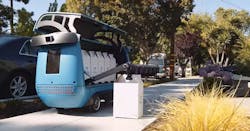Vayu's on-road delivery robot has big brains, bigger plans
Delivery droids have been rolling down sidewalks for a while, bringing small items like pizzas and Slurpees to urban consumers. The cartoonishly cute one from Serve Robotics, which looks like it rolled out of a Pixar movie, started taking on gig work for Uber Eats during the COVID lockdowns.
A startup called Vayu Robotics is taking the premise on the road, literally, with its Delivery Robot. The AI-powered boxy bot is capable of independently navigating city streets (sticking to bike lanes) and inside buildings without pre-mapping, with payloads up to 100 lbs. at speeds up to 20 mph. It also makes drop-offs without human assistance. The robot’s side slides up and over its top so an arm can extend out to drop the package off.
The overall goal is to expand robotic delivery capabilities while pushing down ecommerce costs. For this model, though, which stands at 40" by 70" by 26", Vayu does not want to push the payload limits too much.
“For the last mile delivery problem, we want to keep the overall kinetic energy of the system to be equal to or lower than that of a human on a bicycle,” explained Vayu co-founder and CEO Anand Gopalan. “We believe that this number is around 200 lbs. So with improved design efficiency of the robot and the use of lighter materials, we could increase the payload slightly, but never exceed that 200 lb. number.”
What truly sets this on-road robot apart is that its computing system works like an LLM (Large Language Model). The end-to-end neural network considers the various inputs, or tokens, such as the image from the camera, the instructions from the customer, and route data to navigate to its destination.
“Differently from other LLMs, it has a notion of ‘state’ that is built up over time and is refined with every additional input that is received,” Gopalan said. “This allows for large context windows without the typical slow-down that happens with large contexts.”
Due to its end-to-end neural network and passive sensing, the Vayu Delivery Robot does not rely on lidar. Because of its range, power, and brains, Vayu is targeting larger e-commerce and last-mile jobs. An unnamed “large ecommerce player” plans to deploy 2,500 Delivery Robots.
Vayu’s role in trucking
According to Gopalan, the company’s technology is agnostic and the company’s current Delivery Robot “is only the tip of the iceberg.”
Theoretically, the foundational AI could drive larger types of mobile automated systems like forklifts and yard tractors to move trailers. He also speculated that bi-pedal and quadrupedal robots could also use the software for movement and navigation.
But for now, Vayu said its robot could help speed up parts delivery between a dealer and a nearby fleet terminal.
“We see the systems as capable of democratizing the movement of items like parts within a supply chain ecosystem,” Gopalan said. “When the cost of goods movement is high, it necessitates higher levels of inventory at dealerships, longer lead times for procurement, and a host of planning steps. The deployment of low-cost delivery systems like Vayu’s could enable an almost on-demand approach to parts procurement from a terminal or warehouse.”
He also noted that the Vayu bot can send electronic and/or audible alerts to the receiver so a gate or door could be opened to let it in.
Vayu is backed by $12.7 million in seed funding from Khosla Ventures, along with investments from Lockheed Martin Ventures.
About the Author

John Hitch
Editor-in-chief, Fleet Maintenance
John Hitch is the award-winning editor-in-chief of Fleet Maintenance, where his mission is to provide maintenance leaders and technicians with the the latest information on tools, strategies, and best practices to keep their fleets' commercial vehicles moving.
He is based out of Cleveland, Ohio, and has worked in the B2B journalism space for more than a decade. Hitch was previously senior editor for FleetOwner and before that was technology editor for IndustryWeek and and managing editor of New Equipment Digest.
Hitch graduated from Kent State University and was editor of the student magazine The Burr in 2009.
The former sonar technician served honorably aboard the fast-attack submarine USS Oklahoma City (SSN-723), where he participated in counter-drug ops, an under-ice expedition, and other missions he's not allowed to talk about for several more decades.

